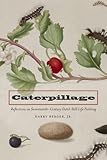Caterpillage : Reflections on Seventeenth-Century Dutch Still Life Painting / Harry Berger.
Material type: TextPublisher: New York, NY : Fordham University Press, [2022]Copyright date: ©2011Description: 1 online resource (140 p.) : 16 Illustrations, black and whiteContent type:
TextPublisher: New York, NY : Fordham University Press, [2022]Copyright date: ©2011Description: 1 online resource (140 p.) : 16 Illustrations, black and whiteContent type: - 9780823233137
- 9780823291113
- online - DeGruyter
| Item type | Current library | Call number | URL | Status | Notes | Barcode | |
|---|---|---|---|---|---|---|---|
 eBook
eBook
|
Biblioteca "Angelicum" Pont. Univ. S.Tommaso d'Aquino Nuvola online | online - DeGruyter (Browse shelf(Opens below)) | Online access | Not for loan (Accesso limitato) | Accesso per gli utenti autorizzati / Access for authorized users | (dgr)9780823291113 |
Browsing Biblioteca "Angelicum" Pont. Univ. S.Tommaso d'Aquino shelves, Shelving location: Nuvola online Close shelf browser (Hides shelf browser)

|

|

|

|

|

|

|
||
| online - DeGruyter Black Robes and Buckskin : A Selection from the Jesuit Relations / | online - DeGruyter Box Boats : How Container Ships Changed the World / | online - DeGruyter Castoriadis's Ontology : Being and Creation / | online - DeGruyter Caterpillage : Reflections on Seventeenth-Century Dutch Still Life Painting / | online - DeGruyter Catholic Social Learning : Educating the Faith That Does Justice / | online - DeGruyter Chancellorsville and the Germans : Nativism, Ethnicity, and Civil War Memory / | online - DeGruyter Check it Out! : Great Reporters on What It Takes to Tell the Story / |
Frontmatter -- Contents -- Illustrations -- Acknowledgments -- Prologue -- 1 Hyperreality and Truthiness -- 2 Reading Blake’s “The SICK ROSE -- 3 Ethics Versus Technics in Seventeenth-Century Dutch Still Life -- 4 Vanitas: The McGuffin of Still Life -- 5 Still Life, Trade, and Truthiness -- 6 The Pretext of Occasion: Floris van Dijck’s Laid Table with Cheese and Fruit, c. 1615 -- 7 Nature Mourant: The Fictiveness of Dutch Realism -- 8 The Embarrassment of Niches: Christoffel van den Berghe’s Vase of Flowers in a Stone Niche, 1617 -- 9 Nature Mourant: Bosschaert’s Leaves, Merian’s Caterpillars -- 10 “Small-scale Violence” -- 11 The Darker Spirit: Van Huysum’s Heaps -- 12 Posies: The Bouquet as Pretext of Occasion -- 13 Joris Hoefnagel and the Roots of Dutch Flower Painting -- Conclusion: Allegorical Capture and Interpretive Release -- Epigraph Sources -- Notes -- Index of Names
restricted access online access with authorization star
http://purl.org/coar/access_right/c_16ec
Caterpillage is a study of seventeenth-century Dutch still life painting. It develops an interpretive approach based on the author’s previous studies of portraiture, and its goal is to offer its readers a new way to think and talk about the genre of still life. The book begins with a critique of iconographic discourse and particularly of iconography’s treatment of vanitas symbolism. It goes on to argue that this treatment tends to divert attention from still life’s darker meanings and from the true character of its traffic with death. Interpretations of still life that focus on the vanity of human experience and the mutability of life minimize the impact made by the representation of such voracious pillagers of plant life as insects, snails, and caterpillars. The message sent by still life’s preoccupation with these small-scale predators is not merely vanitas. It is rapacitas. Caterpillage also explores the impact of this message on the meaning of the genre’s French name. We use the conventional term nature morte (“dead nature”) without giving any thought to how misleading it is. Because so many portrayals of still life involve cut flowers, which, although still in bloom, are dying, it would be more accurate to name the genre nature mourant. The subjects of still life are plants that are still living, plants that are dying but not yet dead.
Mode of access: Internet via World Wide Web.
In English.
Description based on online resource; title from PDF title page (publisher's Web site, viewed 03. Jan 2023)


